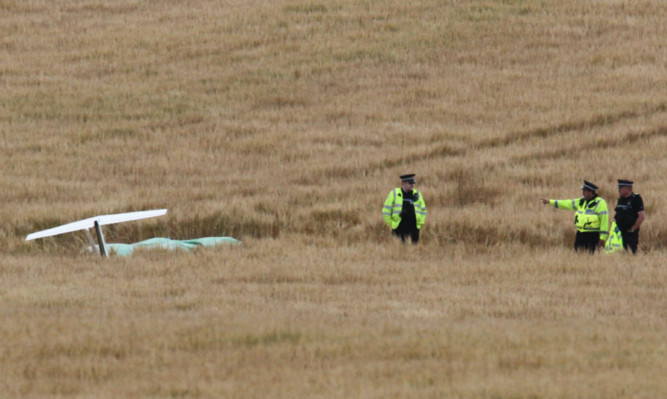A Perthshire pilot was killed after his glider entered a spin from which it did not recover, according to an investigation.
Spittalfield man Ken Smith’s Glaser-Dirks DG-100 glider plunged into a barley field at Pluckerston Farm, just north of Drumshades airfield near Kirriemuir, on August 4 last year.
Emergency services rushed to the scene but Mr Smith was pronounced dead.
The former RAF squadron leader held a bronze gliding certificate and on the day of the accident had intended to carry out a 100km cross-country flight as part of a requirement for a silver certificate.
The Air Accidents Investigation Branch report into the crash, which was published on Thursday, said the launch and accident were observed by a witness near the strip.
“He saw the glider flying in right-hand orbits to the north-east before appearing to enter a steep nose-down spin,” it stated.
“The glider recovered after what he estimated to be about two turns and headed away from the field, to the north, before making another orbit to the right.
“The glider then appeared to enter another spin, from which it did not recover, and was seen to impact the surface of a crop field.”
Experts from the AAIB arrived to make initial inquiries and removed the wreckage to their Farnborough facility.
Part of their investigation included detailed analysis of information gathered from the 59-year-old’s onboard flight data recorder. The report concludes that the aircraft started to descend “rapidly” after making a turn to the right.
The descent was arrested and the glider recovered some height but after another turn it started to descend again, gaining speed and impacting the ground at 11.31am.
The glider’s manufacturer was consulted and concluded that either the airbrakes had been open, or the aircraft had experienced rapidly sinking air prior to the final descent.
The AAIB report carried details of the post-mortem examination.
The pathologist found Mr Smith had died as a result of injuries received in the “non-survivable” accident.
The report said: “While there was some evidence of hypertensive heart disease, which could have produced an incapacitating episode, the circumstances of the accident, including the aircraft recovering from one spin, suggested this was unlikely to have been a factor.
“The glider entered a spin due to the low airspeed whilst turning to the right, with the airbrakes extended to some degree…
“The aircraft did not recover from the spin and the extension of the airbrakes may have delayed the spin recovery.”
